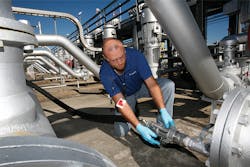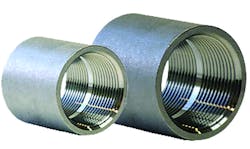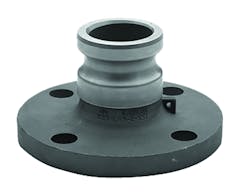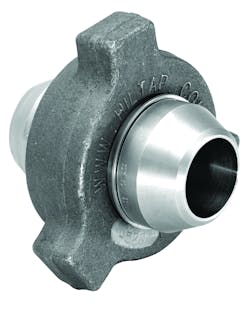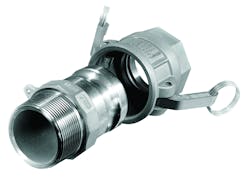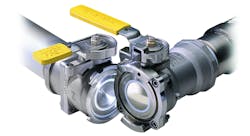The six stages of coupler evolution
Pharmaceuticals, soaps and fuels are all products that solve a type of problem for their industries. As industries evolved, these products have undergone engineered changes to satisfy new process and operational needs. Great product manufacturers constantly strive to improve and develop new products not only to solve industry-related problems but also enhance customer experience.
One industrial product that is an integral cog in the production and supply chain for processes is the coupler. As industries have evolved, the demands for coupler capability have grown as well. Today, couplers must ensure fluid handling applications meet strict safety and regulatory standards. Simultaneously, couplers must provide optimized containment of a wide range of fluids that can have unique and varying operational conditions.
Fluid handling operations have continually demanded reliable connections to avoid leaks or spills of high-value and/or oftentimes hazardous fluids. Some of these fluids may often be flammable, explosive, toxic or even carcinogenic. Further, in many applications with extreme conditions such as high pressure or temperature, connections are required to be more robust.
Coupler manufacturers saw these demands as opportunities to introduce new and improved designs to the market, starting from basic National Pipe Tapered (NPT) threads to cams and grooves to robust ball valves that minimize spills. However, over the years, the range of options to consider for customers when outfitting connections became cumbersome because much research was required before the right coupler could be chosen for the specific fluid handling application.
The remainder of this article looks at how couplers have evolved in six stages over the years to offer solutions and guide end users on which coupler is a fit for their potential application.
Thread
Threads
The first and still most common way to attach a coupler to a hose or pipe is through a threaded connection. Specifically, NPT thread remains the standard for all piping and valve threads in the United States. Unlike the straight threads found on a typical bolt, NPT threads pull together tighter due to the tapered-thread design and increased torque. This reduces the chance for leak pathways to develop.
An important operational benefit of NPT-threaded couplers is that they are intuitive to connect compared to varying styles of hosing or piping. Threaded connections are optimal for use with low-pressure, low-stress piping, and especially in small pipes with diameters of 1 1/2 inches or less.
The main drawback of a threaded connection is that it will wear out over time if the connection is coupled and uncoupled frequently. As a result, it must be monitored on a regular basis so that no leak pathways form. In addition, the connections can be prone to leaks if they are not sealed with Teflon tape or another approved sealant. In high-pressure applications resulting from vibrations or loading, threaded connections are less reliable.
Though the design of threaded connections makes them simple to connect, excessive force from using pipe wrenches to tighten them can create safety and ergonomic issues for operators. Another point to keep in mind is that while more force usually results in a tighter connection, an equal amount of force will be required to undo the connection. This can lead to unintentional damage to the coupler followed by leaks and ultimately repair or replacement.
Flange
Flanges
Flanges are another type of coupler technology that have found success when used in high-pressure fluid-transfer applications. Flanges differ from NPT connections in that they feature two discs that are connected to each other with nuts and bolts, with a gasket situated between them. The use of this gasket improves seal quality and reliability when compared to a basic threaded connection. A properly installed gasket is critical to providing a reliable seal. If installed incorrectly, the flange will inevitably begin to leak.
While they offer advantages in sealing capability, flanged-connection systems require more space and are more expensive to install. Also, because flanged systems are heavy to handle, and a specific number of nuts and bolts are required (4, 8, 16, etc.), they can be time-consuming to connect and may require more operators to install.
Union
Unions
The challenges faced with the handling and installation of flanges led to the emergence of unions as alternatives. The main benefit of unions is that they are easy to connect because they do not require nuts and bolts. Instead, they are threaded for the initial connection, then using a mallet, are hammered to ensure the seal is activated, hence their "hammer union" nickname.
The force applied by the mallet to the union must be distributed as uniformly as possible. Because most unions feature a flat-gasket method of construction, if the force is applied nonuniformly, the gasket can be crushed. This compromises its sealing capabilities and could lead to dangerous and costly leaks or emissions. Because of the risk of gasket damage, the operator will also need to have a ready supply of replacement gaskets on hand. These drawbacks make the use of some unions risky, expensive and unreliable.
Cam and groove
Cam and groove
The invention of cam-and-groove coupler technology was a true step forward. Designed for fluid-transfer operations that require repeated connection and disconnection of the coupler from hoses or piping, the cam-and-groove technology truly ushered in the era of the "quick-disconnect" coupler.
Cam-and-groove couplers feature an autolocking, twin-arm design that locks one hose or fitting into place with another. The female side of the connector has two cams that lock into place in the grooves on the male connector. Like most technologies, there have been improvements made to the original cam-and-groove design since its inception. The most noteworthy has been the development of auto-locking arms that minimize the risk of accidental product release when the arms fall out of the locked position.
While cam-and-groove couplers are used across all industries, they are generally limited to applications where the transfer pressure is 250 psi (17 bar) or less, and they should not be used in any compressed gas service, including steam or air. All cam-and-groove connections should also be dimensioned to meet U.S. Military specification A-A59326.
Dry disconnects
While cam-and-groove couplers were undeniably a step forward in design and operation, they have a clear disadvantage in their operation: when they are disconnected, any residual product that remains in the hose, piping or coupler itself will spill. These open connections, which are often under pressure, could, at the least, result in a slip-and-fall incident, incurred cleanup costs or depending on the fluid being handled, the release of toxic or hazardous materials, resulting in increased risk for the operator.
To minimize this risk, people began combining cam-and-groove couplings with shutoff valves. These valve-quick connect combinations were the launching point for modern dry disconnects. Dry disconnects were a revolutionary coupler technology, and it has continued to be improved over the years. These improvements have been driven by demands for higher flow rates with less spillage. This led to the development of dry-disconnect couplers with increased flow paths and twist-to-connect technology.
The twist-to-connect technology originated in Europe because of the imperative to standardize connections for tank trucks and ISO containers. Additionally, the twist-to-connect technology does not require an operating handle, which makes it more compact and ideal for use in small spaces.
Non-poppeted dry disconnects
The next step in dry-disconnect evolution was the development of a non-poppeted version for use in applications that require the transfer of high-hazard or high-value fluids, where an accumulation of minimal spills becomes a loss for the company. The elimination of the poppet in the coupler’s design results in negligible pressure drop and superior fluid-loss prevention during disconnection. Non-poppeted dry disconnects are the most advanced and most expensive style of coupler. They are frequently the best choice because of the no-spill/no-leak protection offered to facilities that use them.
Another advantage to the non-poppeted coupler’s design is an innovative double-ball-valve system that delivers a tactical balance of unrestricted flow path and double shutoff reliability. Because of this unique design, the cavities do not trap fluid when disconnected from the process lines.
Extreme condition and safety disconnects
The capabilities of the non-poppeted, dry-disconnect coupler were elevated to an extreme level where connections have been engineered to withstand high-temperature and pressure applications.
These connections are compatible in hot and cold environments. Each connection offers a unique design and advantages. Each is vital to preventing fluid leaks, reducing emissions of volatile organic compounds (VOCs) from cryogenic temperatures to upward of 400°F (204°C) and pressures up to 15,000 psi (1,035 bar).
In contrast to extreme-condition couplers, safety breakaway couplers prevent product spills in the event of an unintended disconnect of railcar or tank-truck accident. These safety breakaway couplers are available in many types and sizes but are also application-specific. These systems cannot be installed in a vacuum without considering a host of operational criteria, including the characteristics of the specific media being handled, the transfer system’s pressures and temperatures, the angle of pull and the amount of supported weight on the loading system.
David Morrow is director of product management for OPW Engineered Systems in Lebanon, Ohio. He can be reached at 800-547-9393, ext. 1525, or at [email protected]. OPW Engineered Systems designs and manufactures loading arms, swivel joints, quick and dry disconnects and other related fluid transfer equipment. OPW Engineered Systems is part of OPW, a leading equipment manufacturer in the retail fueling, fluid handling and car wash industries. OPW has manufacturing operations in North America, Europe, Latin America and Asia-Pacific, with sales offices around the world. OPW is part of Dover Corporation.
